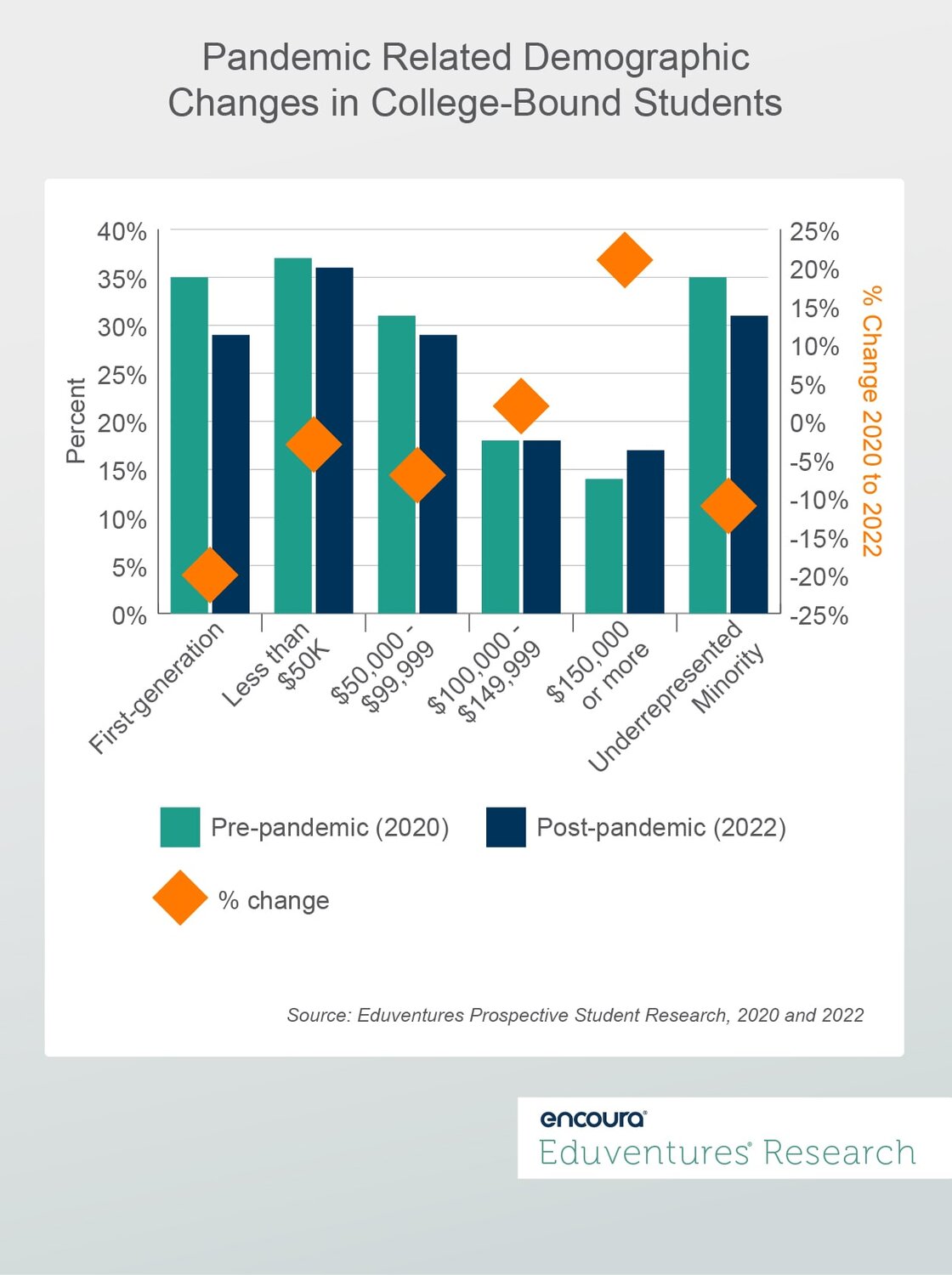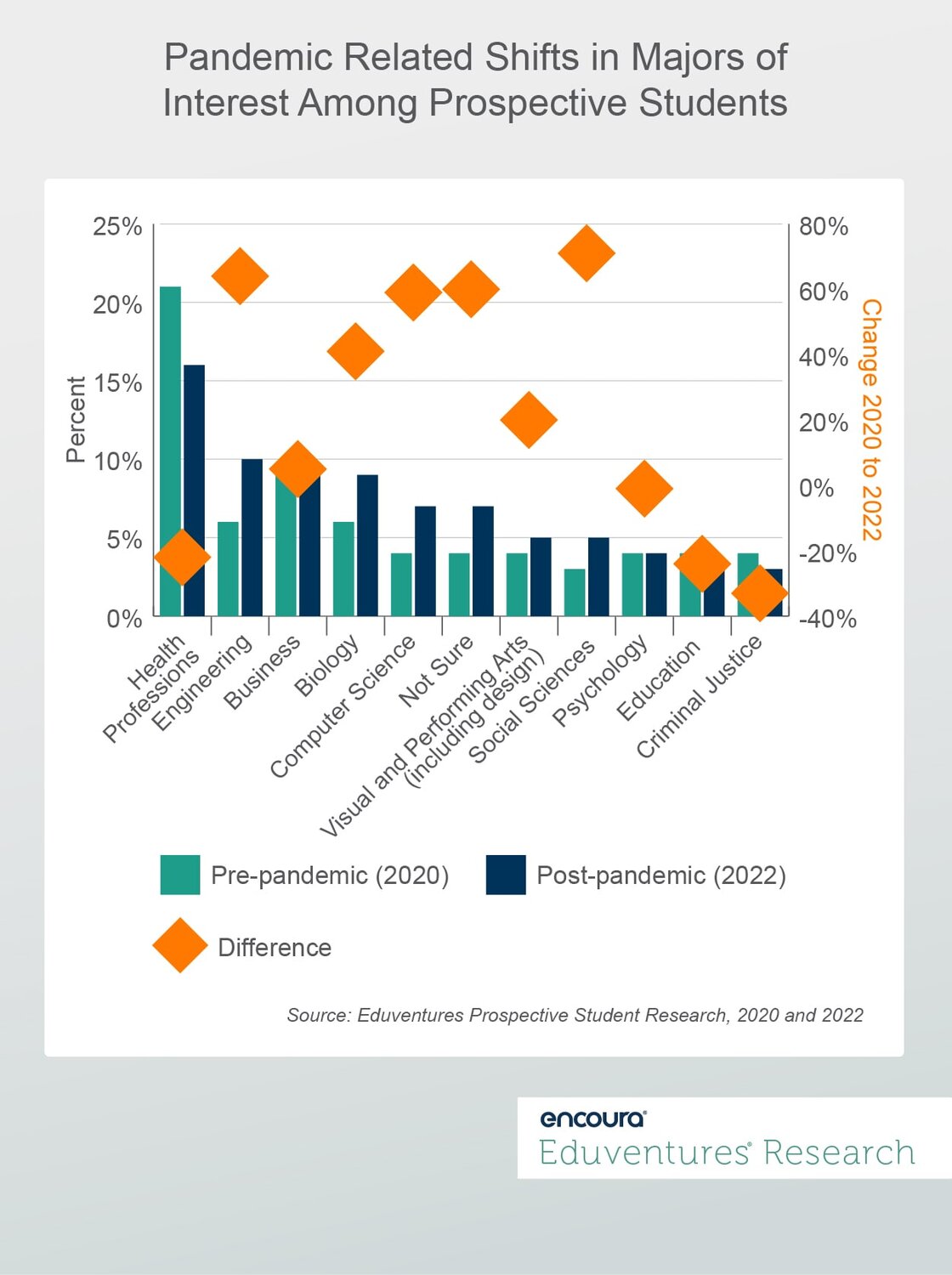What are college-bound students like now? After weathering nearly three years of the pandemic, social upheaval, and economic change, it’s worth asking this question.
Eduventures' Prospective Student Research™ shows that the dynamics of the college-bound market have indeed changed. This not only impacts the composition of Prospective Student Mindsets™ and academic major interests, but also the demographics of the students that remain in the college-bound pipeline itself.
—fewer of whom are low income, first-generation, or underrepresented minorities.
Changing Students, Changing Desires
Let’s start with Prospective Student Mindsets, our annual research that categorizes students into one of six ways of thinking about college. Figure 1 shows the proportion of each Mindset among prospective students in 2020 (pre-pandemic), 2021 (mid-pandemic), and 2022 (“post-pandemic”).

Figure 1 shows that the pandemic has definitively changed the student outlook on college. Prior to the pandemic (2020), we saw one fifth (20%) of students aligned with both the Experiential Interests and the Social Focus Mindsets. We also saw nearly another fifth (19%) aligned with the Career Pragmatists Mindset. Fewer students were identified as Exploration and Meaning (12%) or Grad School Bound (12%).
Mid-pandemic (2021), sudden campus closures had the immediate impact of reducing the percentage of students aligned to Mindsets that placed the most value on hands-on and campus-based experiences: Experiential Interests (-5%) and Social Focus (-4%). Students moved toward Mindsets that focused on the core value of education, but in two different ways. Students in the Career Pragmatists Mindset, which focuses on pure affordability, held steady (+1%). Students who valued academic strength, especially Grad School Bound, increased in proportion (+4%).
We wondered whether these changes would hold post-pandemic (2022). The answer so far? Some have and some haven’t.
The academically-focused Mindsets have continued to flourish. Grad School Bound students are up 6% pre-pandemic to post-pandemic. Career through Academics students are up 3%. We have also seen a continuing decline in Experiential Interests (-7% pre-pandemic to post-pandemic) and Career Pragmatists (-4%).
These changes might be attributable to the environment: the changing dynamics of the pandemic, the economic situation, and social upheaval—students may have different world views due to events. But they are almost certainly related to the changing demographics of students in the college-bound pipeline itself. Our research has shown that first-generation, low-income, and underrepresented minority students are more likely than others to fall into the Experiential Interests or Career Pragmatists Mindset.
Figure 2 shows the pre- and post-pandemic demographics of the college-bound students in our research.

Figure 2 shows that over the course of the pandemic, we have seen a 20% decline in the number of first-generation students and an 11% decline in the number of underrepresented minority students interested in attending a two- or four-year college. On income, we’ve seen smaller declines in the low- to mid-income and a significant increase in the number of high-income students in the college-bound pipeline. These decreases in first-generation, low-income, and minority students certainly can influence the Mindset profile of students who are in the college-bound pipeline, leaving us with more Grad School Bound students proportionally.
A Major Impact
Likewise, shifting demographics, along with roiling thoughts about college, also influence the majors that students are interested in. Figure 3 compares the pre- and post-pandemic majors of interest among prospective students.
Figure 3: Pandemic Related Shifts in Majors of Interest Among Prospective Students
The top major of interest for college-bound high school students is still health professions, but fewer students are interested in this pathway. A major with historically strong interest among first-generation, low-income, and minority students, health professions has seen a 22% decline in interest pre- pandemic to post-pandemic.
Similarly, other majors that are typically stronger draws for first-generation, low-income, and underrepresented minority students such as education (-24%) and criminal justice (-33%) have also seen declines. The opposite is true for majors that tend to draw students who have none of the access factors previously mentioned. Engineering (+64%), computer science (+59%), undecided (+60%), biology (+41%), and social sciences (+71%) have all seen strong increases in interest among today’s college-bound students.
The loss of first-generation, low-income, and underrepresented minorities has left an imprint on current major interests. A more typical balance of major interests won’t be restored until we reconnect with these important and growing demographic segments.
First, these are the students and families who were most likely to have suffered economically during the pandemic. Second, these are the students who were more likely to have deeper learning losses and a resulting loss of confidence in their academic prospects. Finally, these more career-focused students are the ones most likely to take advantage of a strong economy with high wages and low unemployment to move directly into work.
With the possibility of a looming recession, this calculus may change, but there’s no certainty. Can colleges give students good reasons to defer a paycheck and a foot on the career ladder for the sake of a college education?
The Bottom Line
So, what are the implications of all these changes? First, the current market of students has fundamentally changed from pre- to post-pandemic. Students are more likely to have strong academic aspirations. They are less likely to be first-generation or underrepresented minorities. And they are more likely to consider majors like engineering, computer science, and biology and less likely to consider health professions, education, and criminal justice.
Second, these changes are due to both environmental influences on student conceptions of educational value and demographic changes of students in the college-bound pipeline. These conclusions point to two directives for colleges and universities:
1. Work to enroll the students who are actively in your college pipeline.
- Align your messaging to the Mindsets and majors of interest
- Amplify academic messages, especially those that would appeal to Grad School Bound
- Consider how programs like engineering, computer science, and biology will play a role in your current recruiting plans
2. Work to re-establish connections with the students who have stepped out of the college pipeline.
- Include messaging on the value of a higher education
- Expand your search efforts to find students wherever they are
- Consider what school and community outreach can help you stimulate first-generation, low-income, or underrepresented minority interest in college
- Search for Experiential Interests or Career Pragmatists students who are likely missing from your prospective student pipeline
While the data we’ve discussed in this post represents the current state of the traditional undergraduate market, it won’t be the future of the market if we are able to be inclusive and bring a wider array of students back into the college-bound pipeline.
Never Miss Your Wake-Up Call
Learn more about our team of expert research analysts here.
Eduventures Principal Analyst at Encoura
Contact
July 26, 2022 | 2 PM ET/11 AM PT
Institutional leaders must better understand the changing expectations of current and prospective students.
Join Eduventures® Senior Analyst Johanna Trovato and Salesforce Director of Higher Education Industry Marketing, Navneet Johal for a discussion on student perceptions about institutional marketing and communication as well as students’ inherent college search behaviors. This recent data—from the 2022 Eduventures Student Sentiment Research™ —helps enrollment managers develop their marketing and communication strategies for prospective students, informing on best practices in outreach at every stage of the college search.
Reach Gen Z where they are—on their favorite apps and devices—with Encoura Digital Solutions.
How you engage with prospective students and their families needs to evolve with emerging media trends. As a team of experienced enrollment leaders, we work in tandem with your traditional engagement methods and provide targeted digital media strategies to help you navigate the ever-changing digital landscape.


